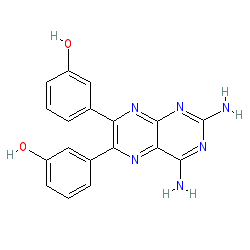GtoPdb is requesting financial support from commercial users. Please see our sustainability page for more information.
|
Synonyms: TG 100-115 | TG 100115 | TG100-115
Compound class:
Synthetic organic
Comment: TG-100-115 is an isozyme-selective inhibitor of phosphatidylinositol-3-kinase (PI3K). The discovery and synthesis of this compound is described in [2], where it is compound 6. It has subsequently been reported to inhibit the kinase activity of the TRPM7 ion channel, an action that suppresses breast cancer cell migration and invasion [3].
Ligand Activity Visualisation ChartsThese are box plot that provide a unique visualisation, summarising all the activity data for a ligand taken from ChEMBL and GtoPdb across multiple targets and species. Click on a plot to see the median, interquartile range, low and high data points. A value of zero indicates that no data are available. A separate chart is created for each target, and where possible the algorithm tries to merge ChEMBL and GtoPdb targets by matching them on name and UniProt accession, for each available species. However, please note that inconsistency in naming of targets may lead to data for the same target being reported across multiple charts. ✖ |
|
|||||||||||||||||||||||||||||||||||
| No information available. |
Summary of Clinical Use  |
| TG-100-115 has been assessed in a single Phase 1/2 clinical trial (NCT00103350), to ascertain its safety and its ability to reduce heart muscle damage in patients having angioplasty following heart attack. There are no other clinical trials for this compound in the ClinicalTrials.gov register (Oct 2018). |
Mechanism Of Action and Pharmacodynamic Effects  |
| Ischemia is believed to trigger VEGF-mediated vascular leakage, and de-regualtion of fluid movement between blood vessels and the interstitium. The PI3K and Src signalling pathways are intimately involved in the regulation of the microvascular processes performed by endothelial cells. In heart attacks tissue is deprived of oxygen (ischemia) and further tissue damage occurs following reperfusion (ie return of blood flow). It is hypothesised that inhibition of the PI3K pathway could help to reduce this type of ischemia/ reperfusion injury [2]. |







